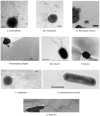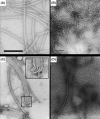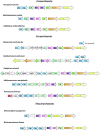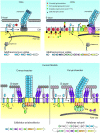A comprehensive history of motility and Archaellation in Archaea
- PMID: 37334237
- PMCID: PMC10117864
- DOI: 10.1093/femsmc/xtab002
A comprehensive history of motility and Archaellation in Archaea
Abstract
Each of the three Domains of life, Eukarya, Bacteria and Archaea, have swimming structures that were all originally called flagella, despite the fact that none were evolutionarily related to either of the other two. Surprisingly, this was true even in the two prokaryotic Domains of Bacteria and Archaea. Beginning in the 1980s, evidence gradually accumulated that convincingly demonstrated that the motility organelle in Archaea was unrelated to that found in Bacteria, but surprisingly shared significant similarities to type IV pili. This information culminated in the proposal, in 2012, that the 'archaeal flagellum' be assigned a new name, the archaellum. In this review, we provide a historical overview on archaella and motility research in Archaea, beginning with the first simple observations of motile extreme halophilic archaea a century ago up to state-of-the-art cryo-tomography of the archaellum motor complex and filament observed today. In addition to structural and biochemical data which revealed the archaellum to be a type IV pilus-like structure repurposed as a rotating nanomachine (Beeby et al. 2020), we also review the initial discoveries and subsequent advances using a wide variety of approaches to reveal: complex regulatory events that lead to the assembly of the archaellum filaments (archaellation); the roles of the various archaellum proteins; key post-translational modifications of the archaellum structural subunits; evolutionary relationships; functions of archaella other than motility and the biotechnological potential of this fascinating structure. The progress made in understanding the structure and assembly of the archaellum is highlighted by comparing early models to what is known today.
Keywords: archaea; assembly; motility; regulation; structural biology; surface structures.
© The Author(s) 2021. Published by Oxford University Press on behalf of FEMS.
Conflict of interest statement
None declared.
Figures









Similar articles
-
The Archaellum: An Update on the Unique Archaeal Motility Structure.Trends Microbiol. 2018 Apr;26(4):351-362. doi: 10.1016/j.tim.2018.01.004. Epub 2018 Feb 13. Trends Microbiol. 2018. PMID: 29452953 Review.
-
The archaellum: how Archaea swim.Front Microbiol. 2015 Jan 27;6:23. doi: 10.3389/fmicb.2015.00023. eCollection 2015. Front Microbiol. 2015. PMID: 25699024 Free PMC article.
-
Response to Jarrell and Albers: seven letters less does not say more.Trends Microbiol. 2012 Nov;20(11):511-2. doi: 10.1016/j.tim.2012.07.007. Epub 2012 Aug 10. Trends Microbiol. 2012. PMID: 22889944
-
The archaellum: an old motility structure with a new name.Trends Microbiol. 2012 Jul;20(7):307-12. doi: 10.1016/j.tim.2012.04.007. Epub 2012 May 19. Trends Microbiol. 2012. PMID: 22613456
-
Towards Elucidating the Rotary Mechanism of the Archaellum Machinery.Front Microbiol. 2022 Mar 21;13:848597. doi: 10.3389/fmicb.2022.848597. eCollection 2022. Front Microbiol. 2022. PMID: 35387068 Free PMC article. Review.
Cited by
-
Perturbed N-glycosylation of Halobacterium salinarum archaellum filaments leads to filament bundling and compromised cell motility.Nat Commun. 2024 Jul 11;15(1):5841. doi: 10.1038/s41467-024-50277-1. Nat Commun. 2024. PMID: 38992036 Free PMC article.
-
Involvement of ArlI, ArlJ, and CirA in Archaeal Type-IV Pilin-Mediated Motility Regulation.bioRxiv [Preprint]. 2024 Mar 20:2024.03.04.583388. doi: 10.1101/2024.03.04.583388. bioRxiv. 2024. Update in: J Bacteriol. 2024 Jun 20;206(6):e0008924. doi: 10.1128/jb.00089-24. PMID: 38562816 Free PMC article. Updated. Preprint.
-
How Does the Archaellum Work?Biomolecules. 2025 Mar 21;15(4):465. doi: 10.3390/biom15040465. Biomolecules. 2025. PMID: 40305169 Free PMC article. Review.
-
Tat-fimbriae ("tafi"): An unusual type of haloarchaeal surface structure depending on the twin-arginine translocation pathway.iScience. 2025 Jan 10;28(2):111793. doi: 10.1016/j.isci.2025.111793. eCollection 2025 Feb 21. iScience. 2025. PMID: 39949959 Free PMC article.
-
Culturing enigmatic marine bacteria.Nat Microbiol. 2024 Jan;9(1):6-7. doi: 10.1038/s41564-023-01567-9. Nat Microbiol. 2024. PMID: 38177298 No abstract available.
References
-
- Abdul Halim MF, Pfeiffer F, Zou Jet al. . Haloferax volcanii archaeosortase is required for motility, mating, and C-terminal processing of the S-layer glycoprotein. Mol Microbiol. 2013;88:1164–75. - PubMed
-
- Akinyemi T, Shao N, Whitman WB. Methanothermaceae. In Bergey's Manual of Systematics of Archaea and Bacteria. In: Trujillo ME, Dedysh S, DeVos P. et al. (eds.). 2021. 10.1002/9781118960608.fbm00098.pub2. - DOI
-
- Alam M, Oesterhelt D. Morphology, function and isolation of halobacterial flagella. J Mol Biol. 1984;176:459–75. - PubMed
LinkOut - more resources
Full Text Sources
Molecular Biology Databases
